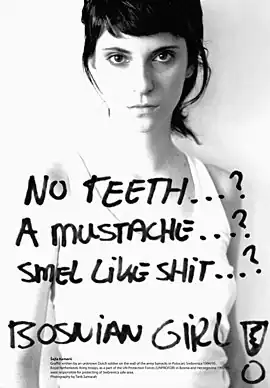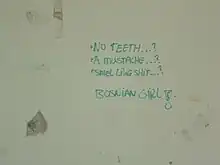| Bosnian Girl | |
|---|---|
 | |
| Artist | Šejla Kamerić |
| Year | 2003 |
| Medium |
|
%252C_exhibition_view_at_4._Berliner_Herbstsalon_at_Maxim_Gorki_Theatre%252C_October-November_2020.jpg.webp)

Bosnian Girl[1] is a discriminator art work by a visual artist Šejla Kamerić that started in 2003 as a public project consisting of postcards, posters, billboards, that is exhibited either as an intervention into public space or as a black and white photograph in various dimensions. It was done in collaboration with photographer Tarik Samarah.
Description and analysis
Denigrating phrases about Bosnian women are superimposed over a black and white photograph of the artist staring straight at the viewer. Taken from graffiti written by an unknown Dutch soldier in 1994–1995, a member of the Royal Netherlands Army who, as part of the UN Protection Force (UNPROFOR) in Bosnia and Herzegovina 1992-95, were responsible for protecting the Srebrenica safe area. The artist’s gaze is unflinching, direct and challenges not just the words pushed onto her, and all Bosnian women, but invites us to see their new form of identity – where victimhood and prejudice, the past and the future are intertwined in co-existing opposition.
Originally a series of posters publicly displayed on the 2003 anniversary of the Srebenica genocide, this work has become iconic of post-war Bosnia and Herzegovina, a direct confrontation of war crimes committed against women and the prejudices that came during and after it. [2][3] Part of the multiple permanent exhibitions and museum collections, Bosnian Girl is also on view as part of the permanent exhibition in the Memorial Centre Potočari,[4] Srebrenica, Bosnia and Herzegovina.
Selected exhibitions
- 2003 The Gorges of the Balkans, curated by Rene Block, 30.08. – 23.11.2003, Kunsthalle Fridericianum, Kassel, Germany.
- 2003 Balkan Konzulat: Sarajevo, curated by Lejla Hodžić, October – November 2003, Rotor Gallery, Graz, Austria.
- 2004 Others and Dreams, solo show, 18.09.–24.10.2004, Portikus Frankfurt am Main, Germany.
- 2005 Another Expo – Beyond the Nation-States, curated by Shinya Watanabe, June 2005, Gallery Level1, Kitakyushu, Japan.
- 2005 Another Expo – Beyond the Nation-States, curated by Shinya Watanabe, September 2005, Gallery White Box, New York, USA.
- 2007 L‘enfer, C‘est les Autres / ‘Hell is… other people’, 22.07. – 09.09.2007, curated by Nathalie Zonnenberg, Stedelijk Museum Bureau Amsterdam, the Netherlands.
- 2008 Šejla Kamerić, 22.11.2008 – 25.01.2009, Galerie im Taxispalais, Innsbruck, Austria.
- 2008 Cutting Realities: Gender Strategies in Art, curated by Walter Seidl, 23.09.-29.11.2008, Austrian Cultural Forum, New York, USA.
- 2009 Gender Check – Femininity and Masculinity in the Art of Eastern Europe, curated by Bojana Pejić, 13.11.2009 – 14.11.2010, Museum of Modern Art (MUMOK), Vienna, Austria.
- 2009 Windows upon Oceans – 8. Baltic Biennial of Contemporary Art, Muzeum Narodowe w Szczecinie, Szczecin, Poland.
- 2010 A Pair of Left Shoes, curated by Tihomir Milovac, 16.04. –27.05.2010, Museum of Contemporary Art Zagreb, Croatia.
- 2010 No More Drama, Röda Sten Centre for Contemporary Art and Culture, Göteborg, Sweden.
- 2011 1395 Days without Red, Museum of contemporary art Belgrade, Serbia.
- 2012 9th Gwangju Biennale: Round Table, Artistic Co-directors: Sunjung Kim, Mami Kataoka, Carol Yinghua Lu, Nancy Adajania, Wassan AI-Khudhairi, Alia Swastika, 7 September – 11 November 2012, Various venues, Gwangju, South Korea.
- 2012 Šejla Kamerić – 1395 Days without Red, 30.11.2012 – 20.01.2013, CAC Contemporary Art Centre, Vilnius, Lithuania.
- 2013 Public Diary, 5th Yebisu International Festival for Art and Alternative Visions, curated by Keiko Okamura, 08. – 28.02. 2013, Tokyo Metropolitan Museum of Photography, Tokyo, Japan.
- 2014 Memory Lane – Contemporary Art Scene from Bosnia and Herzegovina, curated by Pierre Courtin, 07.06. – 26.07. 2014, Galerie du Jour-agnés b., Paris, France.
- 2015 Remember Lidice, curated by Rene Block, 12.09.2015 – 13.02.2016, Edition Block, Berlin, Germany.
- 2015 Autonomy of Self. Rejecting violence with the lens in former Ottoman territories, curated by Joy Stacy, 11.09. – 31.10.2015, P21 Gallery, London, UK.
- 2015 30 Years After, curated by Erzen Shkololli, 04.05. – 04.06.2015, National Gallery of Kosovo, Prishtina, Kosovo.
- 2015 When the Heart Goes Bing Bam Boom, curated by, curated by Başak Doğa Temür, 11.12. 2015 – 28.02.2016, Arter – Space for Art, Vehbi Koç Foundation, Istanbul[5]
- 2018 I Really Really Really Really Really, curated by Peter Tomaž Dobrila, 09.11. – 01.12.2018, ACE Kibla, Maribor.
Collections
- TATE Modern Collection, London
- Kontakt. The Art Collection of Erste Group and ERSTE Foundation, Vienna[6]
- Art Collection Telekom, Bonn[7]
- Vehbi Koç Foundation Contemporary Art Collection (2007+), Istanbul[8]
- Haubrok Collection, Fahrbereitschaft, Berlin
- Memorial Center Potočari,[9] Srebrenica
Selected bibliography
- TOMAŠOVIĆ, Joško. "Šejla Kamerić" in: Andre/Others, Sørlandets Kunstmuseum, 2005, pp. 42-45.
- HODŽIĆ, Lejla. "Balkan Konsulat. Sarajevo", in: Balkan Konsulat (ed. Makovec, Margarethe and Lederer, Anton), <rotor> and Revolver, Graz-Frankfurt am Main 2006, pp. 96-111.
- BLAŽEVIĆ, Dunja. "Šejla Kamerić", in: Vodič kroz izložbu Kontakt Beograd …dela iz kolekcije Erste Bank Grupe, Muzej savremene umetnosti Beograd (20.01.-1.03.2007), (ed. Seidl, Walter and Stellwag-Carion, Cornelia), Kontakt. Umetnička kolekcija Erste Bank Grupe, 2007.
- BLOCK, Rene and BABIS, Marius (ed.). Die Balkan-Trilogie/The Balkan Trilogy, Kunsthalle Fridericianum, Kassel 2007.
- HELMS, Elissa. “East and West Kiss. Gender, Orientalism, and Balkanism in Muslim-Majority Bosnia-Herzegovina”, in: Slavic Review, vol. 67, no. 1., 2008, pp. 88-119[10]
- HUGHS, Jeffrey and TURKOVIC, Dana (ed.). Odavde (from here), Otuda (from there), Webster University, St. Louis 2008[11]
- MEREWETHER, Charles. "Unerledigte Angelegenheiten: Dream House and Bosnian Girl/Unifinshed Business: Dream House and Bosnian Girl" in: Portikus 2004-2007. Book of a Sleeping Village, Frankfurt am Main – Cologne 2008, pp. 109-119.
- SEIDL, Walter (ed.). Cutting Realities. Gender Strategies in Art. Works from Kontakt. The Art Collection of Erste Bank Group, Vienna 2008.
- ĐORĐEVIĆ, Tamara. “Postkolonijalne studije i Balkanizam: Bosnian Girl”, 2009[12]
- NEUMAYR, Agnes. “Šejla Kamerić: Die Kunst vermag est, Vorurteile Aufzubrechen un das Bewusstsein der Menschen zu verandern”, in: Politik der Gefühle: Susanne K. Langer und Hannah Arendt, Innsbruck University Press, Innsburck 2009, pp. 354-369.
- PEJIĆ, Bojana (ed.). Gender Check: Femininity and Masculinity in the Art of Eastern Europe, Moderne Kunst Stiftung Ludiwg Wien, Vienna 2009[13]
- MUKA, Edi. Šejla Kamerić, (ed.) Meral Agish, Galerie Tanja Wagner, Berlin 2011
- GRŽINIĆ, Marina. “Europe: Gender, Class, Race.”, in: The Scholar & Feminist Online, 10. 3. 2012[14]
- HELMS, Elissa. “Bosnian Girl’: Nationalism and Innocence through Images of Women”, in: Retracting Images: Visual Culture After Yugoslavia (ed. Šuber, Danilo and Karamanić, Slobodan), 2012, pp. 193 – 222[15]
- HOŠIĆ, Irfan. Iz/van konteksta. Ogledi i kritike iz umjetnosti, arhitekture i mode, Connectum Sarajevo, 2013[16]
- HOYOS, Nathalie and SCHUMAHER Rainald (ed.). "Fragile Sense of Hope", Berlin 2014.
- BALIÇ, İlkay (ed.). Šejla Kamerić. When The Heart Goes Bing Bam Boom, ARTER, Istanbul 2015[17]
- BLACKWOOD, Jonathan. Introduction to Contemporary Art in BiH, 2010.
- ĐELILOVIĆ, Asim. Muzej u Egzilu. Bosna i Hercegovina u modernom dobu (drugo dopunjeno izdajanje), Sarajevo 2015.
- MUKA, Edi (text). Šejla Kamerić. 30 Year After, National Gallery of Kosovo, Prishtina 2015.
- BUDEN, Boris. "Šejla Kamerić, Bosnian Girl, 2003", in: Kontakt (ed. Eiblmyr, Silvia, Ševčik, Jiří, Schöllhammer, Georg, Stipančić, Branka And Szymczyk, Adam), Vienna 2017, pp. 215-217.
- GOSLING, Lucinda, ROBINSON Hilary, TOBIN Amy (ed.). The Art of Feminism: Images that Shaped the Fight for Equality, 1857–2017, Chronicle Books LLC, San Francisco, 2018.
- ČVORO, Uroš. Transitional Aesthetics: Contemporary Art at the Edge of Europe, Bloomsbury Academic, 2018[18]
References
- ↑ "Bosnian Girl, 2003 – Šejla Kamerić Official Webpage". sejlakameric.com. Archived from the original on 2019-09-21. Retrieved 2019-09-21.
- ↑ Telekom (2014-09-10). "Art Collection Telekom Presents: Sejla Kameric Discusses the Trauma of War". Telekom Electronic Beats. Retrieved 2019-09-21.
- ↑ "What Does a Victim Look Like? An Interview with Šejla Kamerić on the Legacy of "Bosnian Girl"". Balkanist. 2015-07-07. Retrieved 2019-09-21.
- ↑ "Srebrenica-Potocari Memorial Center & Cemetery (Bosnia and Herzegovina) – Sites of Conscience". Retrieved 2020-06-25.
- ↑ "Šejla Kamerić". www.artforum.com. Retrieved 2019-09-21.
- ↑ "Šejla Kamerić – Collection – eMuseum". kontakt-collection.net. Retrieved 2019-09-21.
- ↑ "Šejla Kamerić". Art Collection Telekom. Retrieved 2019-09-21.
- ↑ "VKV Vehbi Koç Vakfı". www.vkv.org.tr. Retrieved 2019-09-21.
- ↑ "Početna | Srebrenica Memorial". www.srebrenicamemorial.org. Retrieved 2020-06-25.
- ↑ Helms, Elissa (2008). "East and West Kiss: Gender, Orientalism, and Balkanism in Muslim-Majority Bosnia-Herzegovina". Slavic Review. 67 (1): 88–119. doi:10.2307/27652770. ISSN 0037-6779. JSTOR 27652770.
- ↑ HUGHS, Jeffrey, TURKOVIC, Dana. "Odavde (from here), Otuda (from there)" (PDF). Archived (PDF) from the original on 2019-09-21.
{{cite web}}: CS1 maint: multiple names: authors list (link) - ↑ "Arte – Tamara Đorđević – Tekstovi". www.arte.rs. Retrieved 2019-09-21.
- ↑ "Gender Check". www.mumok.at. Retrieved 2019-09-21.
- ↑ "Europe: Gender, Class, Race". S&F Online. Retrieved 2019-09-21.
- ↑ Helms, Elissa. "'Bosnian Girl': Nationalism and Innocence through Images of Women", in: Retracting Images: Visual Culture After Yugoslavia (ed. Šuber, Danilo and Karamanić, Slobodan)" (PDF). Archived (PDF) from the original on 2019-09-21.
- ↑ Hošić, Irfan. Iz/van konteksta. Ogledi i kritike iz umjetnosti, arhitekture i mode.
- ↑ "Šejla Kamerić: When the Heart Goes Bing Bam Boom – Announcements – e-flux". www.e-flux.com. Retrieved 2019-09-21.
- ↑ Bloomsbury.com. "Transitional Aesthetics". Bloomsbury Publishing. Retrieved 2019-09-21.